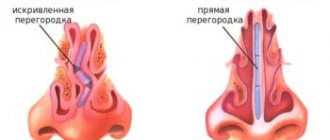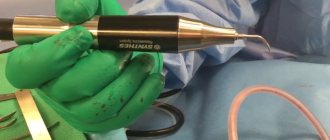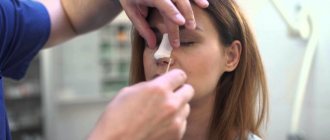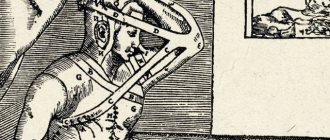Every year I perform more than 450 plastic surgeries, the lion's share of which are correction of the shape of the nose. Approximately 30% of them are allocated to revision rhinoplasty. It is interesting that it is usually decided on by men and women whose primary operation was performed in a closed manner. The “age” of the noses is approximately the same – from 3 to 7 years. It was since the end of the 2000s that closed rhinoplasty gained fame as a “sensational discovery” in Russian aesthetic medicine. Now people have to deal with its consequences - “dents”, deformations, drooping of the tip and other characteristic defects.
Alas, some of my colleagues are still replicating the closed method to the masses, and ordinary people sleep and see how they find the perfect nose “without a hitch.” What attracts doctors who offer such services? No scars, protection from bleeding, instant recovery?
I am ready to personally debunk all the myths associated with closed rhinoplasty so that you, dear readers and potential patients, can evaluate its advantages and disadvantages objectively.
“Bloodlessness” and “painlessness” are a bluff!
The essence of closed (endonasal) rhinoplasty is the formation of a specific access through the mucous membrane of the nostrils, supposedly less traumatic and more effective.
MYTH: Closed rhinoplasty involves less tissue and fewer incisions. Comments: When performing an endonasal operation, all the skin is peeled off in the same way as with the open method, and exactly the same vessels are cut. The only exception is that the skin isthmus of the nose between the nostrils remains intact - in the lower part of the columella.
By the way, a huge number of vessels and capillaries are connected to the mucous membrane of the nasal cavity and the skin, which are necessarily injured during surgery, regardless of its type. Therefore, there will be no less blood, if not more, with closed rhinoplasty than with open rhinoplasty. Healing after open rhinoplasty lasts exactly the same and depends on the individual characteristics of the patient’s body. And you will have to wear a cast in any case!
MYTH: Surgeons allow excessive bleeding during open surgery. With closed rhinoplasty, the absence of postoperative hematomas is promised. Supposedly, this technique “bypasses” large vessels and minimizes the release of blood from wounds, so there will be fewer bruises or no bruises at all.
- Firstly, the presence and severity of hematomas depends on the accuracy of the osteotomy;
- Secondly, the presence and extent of hematomas and bruises are controlled and corrected using decongestant therapy administered during surgery, and its success often depends on the anesthesiologist (!!!).
- Thirdly, an adequate surgeon will under no circumstances allow the patient’s face to resemble one big consequence of severe beatings after nose correction. He will oversee the preparatory (preventive) process, and during the intervention he will work extremely delicately and carefully.
MYTH: Closed rhinoplasty is less painful. Surgeons involved in PR for the “author’s” closed rhinoplasty claim that it is painless. Comments: I’ll tell you a secret - any plastic surgery is painless, especially rhinoplasty, since it is performed either under local anesthesia combined with intravenous sedation, or under general anesthesia. Despite the complexity of the process, rhinoplasty is characterized by easy rehabilitation - during the recovery period, the patient feels pain and discomfort only in exceptional cases. And this concerns rather the individual characteristics of the body, so the specific principle of rhinoplasty does not play a role here. And finally, a more or less realistic argument in favor of closed rhinoplasty is the absence of scars on the external nose (on the columella).
MYTH: Open rhinoplasty scars are visible and detract from your appearance. Comments: After open rhinoplasty, the scars completely disappear after 15-20 days - not a trace remains on the skin from surgical manipulations. Proper wound suturing is taught in medical institutes. And if the doctor insists on closed rhinoplasty, citing the absence of scar changes, perhaps he has not mastered the program well?
MYTH: Closed rhinoplasty is faster than open rhinoplasty. Comments: No, if you do high-quality closed rhinoplasty, then the time spent on the operation can be spent even more than with the open correction method.
It is impossible to do good work in 30-40 minutes that will not change over time.
When and who can have a nose job?
This is not a rhetorical question. Adolescence, with its maximalism and self-doubt, encourages teenagers to treat their appearance with increased demands and a desire to change something. And, oddly enough, the first thing that comes into view is the nose. But no plastic surgeon will undertake an operation unless he receives permission from the teenager’s parents. It’s another matter if, under the influence of hereditary factors or injuries, a teenager has difficulty breathing through his nose. Often surgery is not possible. But in such cases they resort to septoplasty. The purpose of this surgical intervention is to correct individual elements inside the nose: the septum, nasal turbinates, and restoration of shape. And such an operation is not performed by plastic surgeons, it is performed only by an otolaryngologist. Another factor that is a contraindication for rhinoplasty for teenagers is that the facial features of a child under 20 are constantly changing (growing with him), therefore, upon reaching adulthood, you can get something completely different from what was originally intended.
All other adults, regardless of age, can undergo nose surgery. Advice: if you decide to undergo an operation such as rhinoplasty, undergo computer modeling so that you know approximately what you will look like. Otherwise, you may be disappointed...
Can closed rhinoplasty completely correct the nose?
Closed rhinoplasty is generally quite simple to perform and even novice surgeons can handle it. In addition to this, it provides strictly limited opportunities for medical manipulation. With its help, small corrections are made, and only in this case can you guarantee a positive outcome. However, the consequences of the correction may appear after the intervention. For example, after closed rhinoplasty, delayed complications such as dips in the bridge of the nose and breathing problems are common.
The main reason for these consequences is the limited ability to repair, reconstruct and fix the upper lateral cartilages and nasal valves properly. Changes in the position of the tip of the nose are also often observed: this is a kind of insidiousness - the first few years after the procedure, the nose looks acceptable, and then suddenly “metamorphoses” begin: the tip drops or lifts up.
This method in its complex version is extremely technically complex, both in duration and execution. Only a true master and virtuoso can perform a high-quality closed rhinoplasty. But a knowledgeable doctor will choose a guarantee of an excellent result, rather than the difficulty of execution.
When is closed access relevant?
Having attended major professional conferences in Russia, Europe and the USA, I can confidently say that in the West almost no one practices closed rhinoplasty, with the exception of some Turkish surgeons. It is occasionally performed at the patient’s insistence. In all other situations, European and American surgeons, including “star” ones, perform only open rhinoplasty.
Ask the surgeon guiding questions
Ask a specialist:
- How can you peel off the skin from soft tissues without blood and pain?
- How can nasal tip correction be performed without normal access to the lower lateral cartilages? Is it really possible to get a thin tip without sewing them together?
- How can closed rhinoplasty be absolutely bloodless if it also involves making an incision, but inside the nostrils along the mucous membrane (which, by the way, is much more sensitive than the skin), and then also peeling off the skin? Is this street magic?
I strongly recommend asking your surgeon for photographs and videos of his surgical results from all angles. As practice shows, intrusive and aggressive advertising is supported by “evidence” in the form of a couple of photographs strictly in profile, from which, in principle, one cannot judge the final quality of the work.
Indications for revision rhinoplasty
- Impaired respiratory function of the nose.
- Aesthetic defects resulting from incorrect tissue redistribution.
- Patient dissatisfaction with the result of rhinoplasty.
- Pronounced scars on the outside of the nose;
- Depression of the bridge of the nose, depression.
- Nasal asymmetry;
- A hump in the nose that appears after primary rhinoplasty.
When can revision rhinoplasty be done?
Many patients ask: “How long before revision rhinoplasty can be done?” So, repeated plastic surgery can be done only after the nose has completely healed! You can talk about repeat nose surgery only after 6, or better yet, 12 months.
Example of revision rhinoplasty
“Revision rhinoplasty is a world of its own. Here we are approaching the theme of reconstruction, that is, the re-creation of something lost. It sounds a little scary, but any rhinoplasty is the removal or modification of bones and cartilage, therefore after the first operation they are in an altered state or removed. That is, the first serious point is that some tissues or parts thereof are missing. Second point. Patients who come for repeat surgery often have dense internal scars, which also deform the internal structures of the nose and cause distortion of its shape. So, to perform a good revision rhinoplasty, we often have to recreate cartilage or bone, remove scar tissue... Where does the missing material come from? If the nasal septum is preserved, then this is the first donor area. We can take the cartilage from there. Or use ear or rib cartilage.”
Tamarov Alexey Nikolaevich plastic surgeon
Benefits of classic open rhinoplasty
I have highlighted the key advantages of traditional rhinoplasty that closed rhinoplasty cannot boast of:
- Multifaceted possibilities for any type of correction due to unhindered access to all components of the nasal frame;
- Equal availability of bone and soft tissues, as well as upper and lower cartilage (which allows you to successfully model both the back and the tip of the nose);
- Minimal probability of error (as opposed to closed rhinoplasty, which is essentially performed “blindly”);
- Availability of all resources for working in innovative techniques (for example, win-win structural rhinoplasty is performed only from open access);
- Visibility of the effect (the corrected nose, which the surgeon sees at the final steps of the operation, will be the final result);
- No postoperative complications or changes in the shape of the nose.
Rehabilitation
The recovery process after revision rhinoplasty is somewhat more complicated than after the primary operation. This is due to scar tissue that undergoes repeated excision. Swelling and hematomas after secondary surgery can last more than 10 days. Otherwise, rehabilitation after revision rhinoplasty is no different from primary one.
To speed up the healing process of the nose after secondary nose correction, you must follow the surgeon’s recommendations:
- For the first 2 weeks, it is advisable to sleep on your back, on a high pillow;
- You should not wear glasses until recovery is complete;
- Observe restrictions on physical activity;
- It is necessary to protect the face from exposure to ultraviolet radiation;
- Avoid alcohol, coffee and smoking in the first days after discharge;
- Try not to eat too hot or cold food and drinks;
- Avoid hypothermia, viral and infectious infections.
Revision rhinoplasty is a more complex operation, both technically and psychologically. Therefore, if you are faced with the need for secondary rhinoplasty, take the utmost responsibility in choosing a rhinosurgeon. In the case where complications arose through no fault of a specialist, then it is necessary to contact him for revision rhinoplasty. The doctor knows all the characteristics of your body, can predict the result and select the optimal treatment tactics.
What is the difference between rhinoplasty, septoplasty and rhinoseptoplasty?
| Operation name | Area being operated on | Indications | Results of the operation |
| Septoplasty | Nasal septum area | Correction of the shape of the nose, improved breathing, prevention of snoring, nosebleeds. | Treatment of ENT diseases, improvement of breathing. Restoring the proportions of the right and left sides of the nose. |
| Rhinoplasty | The entire nasal surface area | Injuries, bruises of the nose, difficulty breathing, improvement in the appearance of the nose. | The ideal appearance of the nose, its shape. |
| Rhinoseptoplasty | It is done on the entire area of the nose, including the septum. | Deviated septum, breathing problems. The patient's desire to give the nose the desired shape. | Correct shape and ideal appearance of the nose, restoration of breathing. |
Performing laser rhinoplasty
Before a patient undergoes laser rhinoplasty, he will have a consultation with a specialist who will prescribe a series of tests, such as: a general urine and blood test, a biochemical blood test; blood for hepatitis, HIV and syphilis, as well as ECG and fluorography. Sometimes specialists may need an X-ray of the nose, an ultrasound of the internal organs and an otolaryngologist’s report to get a complete picture of the patient’s health. Only after receiving all the test results and studying them, the doctor can set a date for the operation. It is recommended to stop taking blood thinning medications a week before laser rhinoplasty, and also stop smoking and drinking alcohol. The last meal is allowed 8 hours before surgery. On the eve of laser rhinoplasty, it is a good idea to wash your hair, take a shower, and remove nail polish. You should not apply any creams to your face before surgery. After completing the preparatory stage, on the appointed day of the operation, the patient arrives at the clinic, where he is provided with a hospital room in which he can change clothes and wait for the operation to begin. When all specialists are ready, the patient is invited to the operating room. After this, the patient’s skin is treated with an antiseptic and the doctor makes marks with a marker along which the incisions will be made. Anesthesia is then administered. The only difference between laser rhinoplasty and conventional rhinoplasty is that a laser is used instead of a scalpel. The operation can be performed using an open or closed method. It depends on the problem being solved and the convenience of rhinoplasty. Thanks to the laser, the operation is bloodless, because it is able to seal the vessels immediately. When all manipulations are completed, cotton pads are inserted into the nose, and a plaster bandage is applied on top. At this point, laser rhinoplasty is considered complete. The total operation time ranges from 40 minutes to an hour. After this, the patient is sent to a hospital, where it is recommended to spend at least a day under the supervision of specialists.








